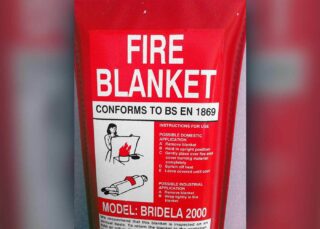
A fire blanket is a safety device used to extinguish small fires. In the past, asbestos was woven into fire blankets. As a result, individuals who used fire blankets were at risk of asbestos exposure.
Asbestos exposure is dangerous and may lead to an asbestos-related disease, such as mesothelioma. Asbestos fire blankets are no longer made in the United States. However, the product may still be present in some homes and jobsites.
What Is an Asbestos Fire Blanket?
A fire blanket is a nonflammable sheet designed to smother a fire by covering it. Before asbestos laws and regulations were established, fire blankets were made with asbestos.
Asbestos fibers were woven into fire blankets to increase strength and heat resistance. Asbestos was commonly used as a fireproofing material because of the mineral’s fire-resistant qualities.
Asbestos fire blankets, or asbestos blankets, are no longer manufactured or imported into the U.S. However, asbestos blankets manufactured in the past may still be present in some U.S. homes and jobsites.
Asbestos blankets are also still produced in several countries around the world.
Every year, the mesothelioma community recognizes Global Asbestos Awareness Week from April 1 – 7. Global Asbestos Awareness Week serves to educate the public about the dangers of asbestos exposure. Without a national ban on asbestos, this week reminds Americans of the asbestos products that may linger across the country, such as fire blankets.
How Asbestos Blankets Were Used
Asbestos blankets were designed as safety devices. They could be found in industrial settings, laboratories and homes. They may have been kept in kitchens, near ovens, stoves and other areas where fires are likely to occur.
In the event of a small fire, an asbestos blanket could cover the fire and prevent it from drawing oxygen from surrounding air. They may also be wrapped around a person’s body for protection.
Asbestos blankets were meant to protect workers and homeowners from fires and hot equipment. However, the asbestos product was dangerous and put users at risk of asbestos exposure.
Who Is at Risk of Asbestos Exposure From Fire Blankets?
Anyone who handled or used an asbestos fire blanket may have experienced asbestos exposure. This includes workers, homeowners and military service members.
When in use, asbestos blankets may release asbestos fibers into the air. If asbestos becomes airborne, small fibers can be easily inhaled or ingested.
Occupational Exposure From Asbestos Blankets
In addition to at home use, a variety of occupations used asbestos blankets on the job. Industrial workers frequently used asbestos blankets to insulate hot pipes and furnaces.
Welders specifically used asbestos blankets to protect workers from sparks and hot equipment. In some cases, these workers cut asbestos blankets or asbestos cloth that came in large rolls. When the material was cut, asbestos fibers may have been released into the air.
Workers who used asbestos blankets may have been susceptible to asbestos exposure. Before the 1970s, workers were often not aware of the dangers of asbestos. They were also not commonly provided with protective equipment.
As a result, many individuals who came into contact with asbestos blankets are at risk of developing asbestos-related diseases.
Some workers may also still be at risk of asbestos exposure from old asbestos blankets in use today.
Health Impacts of Asbestos Blankets
Individuals who handled or worked near asbestos blankets are at risk of developing mesothelioma or another asbestos-related disease.
After exposure, mesothelioma may take decades to develop in the body. This means workers and other individuals exposed in the past may still be at risk of developing mesothelioma.
Individuals diagnosed with mesothelioma after contact with an asbestos blanket may seek compensation. Companies that manufactured asbestos blankets may be responsible for the asbestos exposure.
Today, fire blankets are commonly made with silicone and fiberglass. However, some asbestos fire blankets may still be in circulation.
Unless the product is labeled, it may be difficult to tell if a fire blanket contains asbestos. An asbestos-abatement professional can help dispose of dangerous asbestos-containing materials.
Image attribution: “Fire Blanket” by Sean MacEntee is licensed under CC BY 4.0




